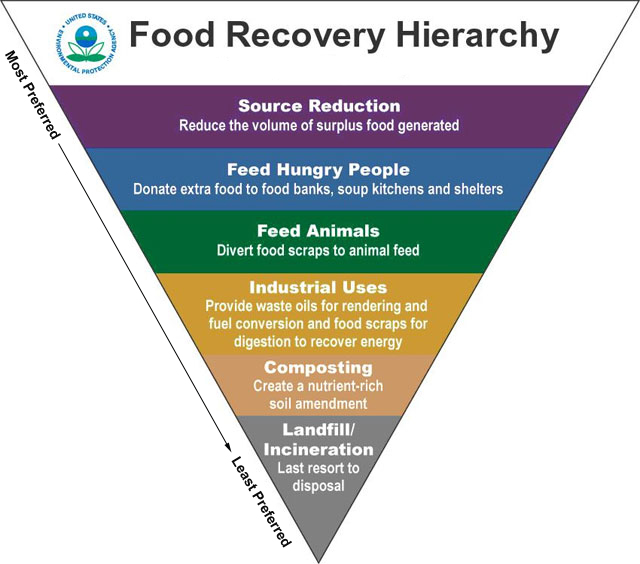5 Ways to Reduce Large-Scale Food Waste
Monica Walker
In the past several years, food waste reduction strategies have become more innovative, both with residential food waste and larger amounts of food waste from commercial establishments. To date, composting and feeding the hungry have been popular strategies to reduce food waste.
The EPA hierarchy provides a great resource for thinking about food waste reduction strategies and today we’ll take a look at examples for each level.
Source Reduction
A New England grocery store, Hannaford Supermarkets, has implemented a food waste source reduction strategy to prevent food waste from entering their waste stream. This plan includes strategies like having delivery trucks move less food to individual stores on a daily basis, rather than less frequent deliveries of larger volumes of food. The result is that once delivered to the store, produce stays fresher, for longer and creates less waste.
Feed hungry people
Trader Joe’s has an established food donation program that gives products not fit for sale, but still safe for consumption, to local food banks, food pantries, and soup kitchens. The recipients distribute the recovered products to people in need. In 2014, Trader Joe’s donated $295 million worth of food that would otherwise have gone to landfill.
Feed Animals
The St. Paul Public Schools in Minnesota have collected food scraps since 2005 to give to Barthold Pig Farm. The schools collect an average of 7.0 tons of food scraps per day. Sending this waste to a pig farm instead of landfill saves $975 per day in landfill disposal fees. Since the program’s start, the schools have saved $817,000 total; enough to hire 3 full-time teachers.
Industrial Uses
Industrial uses refers to methods that recover energy from food scraps. One method included in this category is anaerobic digestion, which turns food waste into energy and fertilizer. Some wastewater treatment facilities are equipped with anaerobic digesters to treat wastewater, and the microbes that render the wastewater inert, are also capable of processing food waste. For example, the Los Angeles Joint Water Pollution Control Plant employs this approach. The facility and Waste Management (WM) are piloting a program that takes collected restaurant and grocery store unsellable food and turns it into a food waste smoothie-like product at a waste management facility. This mixture is then added to the anaerobic digester for co-digestion. WM collects and processes approximately 84 tons of food waste per day, and this is turned into biogas, a renewable energy source, utilized to power the facility.
Composting
One of the more well-known municipal composting programs is in San Francisco. The city has had an established residential collection program for nearly 15 years, and now mandates the separation of recyclables, compostables, and landfill trash. The city has also created a toolkit for businesses to help them reduce food waste, and comply with the compost regulations.
A Look Ahead
Food waste reduction wins on three fronts: lower costs for disposal, production of an excellent end product/soil amendment, and significant reduction in GHG emission. The next step with food waste reduction is to make it as financially attractive as possible, enabling individuals, companies, and hospitals to reduce food waste at a high level.
Monica Walker is a summer intern at RRS primarily focused on a food waste reduction project, with recent work experience at an automotive company managing their air and water compliance. She is a rising senior at the University of Michigan, studying Environmental Engineering and Urban Studies and has a job on campus at the Graham Sustainability Institute.

